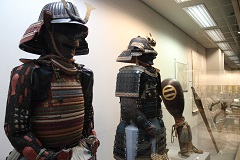Naegi Castle History and the Toyama Family
Naegi Castle was the stronghold of the Toyama family until Naegi domain (part of present-day southern Gifu Prefecture) was abolished in the aftermath of the Meiji Restoration of 1868. The original surname of the family was Kato, and they traced their line back to Kato Kagekado (1156–1221), a retainer of Minamoto no Yoritomo (1147–1199), founder of the Kamakura shogunate. In 1195, the family changed their surname to Toyama in honor of Mt. Ena, a towering 2,191-meter peak to the south of Nakatsugawa City. At the time, the peak was called Toyama, meaning “distant mountain.” In 1526, the family chose Mt. Takamori as their castle site, the better to control the Kiso and Hida areas at a pivotal location on the Kiso River and the Nakasendo highway, as well as expand their influence in eastern Mino Province.
Surviving in a time of war
In 1526, Toyama Masatoshi established Naegi Castle as the administrative center of Naegi domain. Close ties between the Oda and Toyama families meant that Naegi Castle was considered an important defense against the rival Takeda family of Kai Province (present-day Yamanashi Prefecture).
Oda Nobunaga (1534–1582) was the first of “three unifiers” who brought about the end of the Sengoku (Warring States) period (1467–1568). After Nobunaga was killed at Honnoji Temple in Kyoto by a trusted general, Akechi Mitsuhide (1528–1582), Toyotomi Hideyoshi (1537–1598) began jockeying to succeed Nobunaga as unifier of the realm. The Toyama family, which did not swear allegiance to Hideyoshi, were forced to flee their castle by Hideyoshi’s general, Mori Nagayoshi (1558–1584).
The Mori family made Kawajiri Hidenaga their castellan and the Toyama family fled, allying themselves with Tokugawa Ieyasu (1543–1616) in Owari Province. Ieyasu would eventually challenge Hideyoshi and his allies in the Battle of Sekigahara in 1600 and complete the unification of the country. Just before that, Ieyasu sent Toyama Tomomasa, the head of the family, to retake Naegi Castle and the former Toyama territory. Castellan Kawajiri was killed at the Battle of Sekigahara in 1600, and after Ieyasu emerged victorious, Naegi Castle and the domain were awarded to Tomomasa. Thereafter, twelve generations of the Toyama family ruled Naegi domain until the change of regimes led to their removal from power in 1871.
Ruling in a time of peace
In the peaceful Edo period, many mountaintop castles were abandoned in favor of more accessible castles on plains. The Toyama family resisted this temptation to move and kept the castle their family had built over generations. During the Edo period (1603–1867), Nakatsugawa was a major transportation hub. It was next to the Kiso River and was the 45th post station on the Nakasendo, one of five main highways that connected Edo (modern-day Tokyo) to Kyoto. The domain was strategically important, as it controlled both the land and river routes between Owari and Mino Province.
Naegi was one of the smallest domain to have a castle and was valued at a relatively modest 10,000 koku (approx. 50,000 bushels) of rice produced annually. Koku was a unit for measuring rice and was used to determine land value for taxation under the Tokugawa shogunate. One koku (roughly equivalent to five bushels of rice) was theoretically enough rice to feed one person for a year.
The end of an era
As one of the poorest domains, Naegi faced a difficult financial situation and struggled to grow enough rice to support itself. When the castle was dismantled in 1871, the timber and other items of value were auctioned to help pay off the domain’s accumulated debts.

This English-language text was created by the Japan Tourism Agency.
(この英語解説文は観光庁の地域観光資源の多言語解説整備事業で作成しました。)
この記事に関するお問い合わせ先
商工観光部観光課
電話番号:0573-66-1111(内線4272・4273)
メールによるお問い合わせ














更新日:2025年03月05日